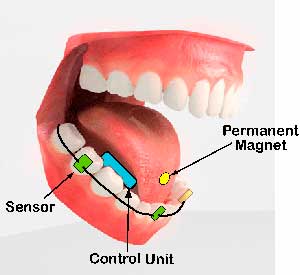
Maysam Ghovanloo
The tongue just received a reassignment from the food service department to the information technology division.
Thanks to the tongue drive, a device invented by electrical engineering professor Maysam Ghovanloo and his students, the tongue will soon be clicking and dragging, controlling precision computer operations for quadriplegics and others for whom the usual appendages just don’t work.
The system will rely on four essential components: a stylish magnetic tongue stud, a series of sensors installed on orthodontic braces or retainers, a coin-sized wireless control unit anchored under the tongue and a personal digital assistant (PDA) worn on the belt or attached to a wheelchair.
The sensors track the location of the magnetic tongue stud within the mouth and transmit the information to the control unit, which relays it to the PDA for processing. A wireless signal from the PDA can then control a computer or any other device that has been modified to receive the signal — from light switches to televisions.
“Most people who suffer from spinal cord injuries have a long life ahead,” Ghovanloo said. “Our goal is to enable them to live a more independent life. If they can operate a computer, they can communicate, chat, access information and control other devices.”
Well over half of America’s 250,000 quadriplegics are under the age of 30, according to the National Spinal Cord Injury Association, and many survive 30 to 50 years after the spinal cord injury.
While various reassignment technologies are already available to quadriplegics, Ghovanloo says they leave much to be desired — in terms of both looks and versatility.
“A lot of these devices represent cool engineering advances, but they never become popular in the market because they’re not cosmetically acceptable — they involve patches, electrodes and wires,” he said. “Disabled people are already different from intact people, so the last thing they want is to look different too.”
Apart from their sometimes distracting appearances, the devices may be laborious or impossible to use for those with more severe injuries. Some devices use head movements to control a cursor on a computer screen — but many spinal cord injury patients have lost the ability to move even their heads.
Another popular device, the sip and puff switch, allows users to control devices without head movement. But it only delivers a simple on/off or yes/no command, so performing complex operations can require a long and slow series of operations.
The tongue drive promises advantages over these existing technologies.
“It tracks tongue movement in a very unobtrusive way,” Ghovanloo said. “It is based on tongue studs and orthodontic braces — two things that are already in place and that intact people also use. So it’s cosmetically acceptable. Users won’t look like aliens.”
And because the tongue is connected directly to the brain via the hypoglossal nerve, rather than the spinal cord, it remains functional even in those with the most severe spinal cord injuries.
Finally, the tongue drive will work more like a joystick than a switch, conveniently accommodating a wide range of commands.
Ghovanloo had the idea for the tongue drive in 2005, when he came across a scientific paper from the 1970s describing an electrode array that could be applied to the tongue. When attached to a camera, the array would transmit electrical stimuli to the tongue in a pattern representing a visual image. “It was a crude way for a blind person to see,” Ghovanloo said — and it planted the seed from which the tongue drive grew.
Now, a year and a half later, the University has a provisional patent on the tongue drive, and Ghovanloo’s lab has assembled an early prototype that uses a football mouth guard rather than orthodontic braces. The mouth guard is wired to a pocket control unit, rather than communicating with a wireless unit under the tongue.
But the prototype is working. Using only the tongue, users can track a moving dot around a computer screen in a game designed specifically to test the device.
So now it’s a matter of refining and shrinking the tongue drive — and this is where Ghovanloo’s new graduate students, Xueliang Huo and Jia Wang, come in. If they work quickly, real patients might be testing out the tongue drive within one year.
Huo, who joined the program four months ago with a masters degree in mechanical engineering, will work on condensing the hardware to fit inside the mouth, and refining the software to more precisely track the tongue’s location. The hardware part will be easy he says; the biggest challenge will be to devise algorithms that calculate the 3-D position of the tongue based on the signals from the magnetic sensors inside the mouth.
Once Huo has the circuitry and algorithms sorted out, Wang’s software will process the tongue drive signal, converting it to a command that a computer can recognize.
“If Xueliang collects the electric signal and gets a certain voltage, I will translate that voltage to a command,” she said. “That way the tongue can move the cursor right, left, up or down, and select or cancel.”
Wang is quick to point out that the technology has “fun usages” too. She can imagine the same principles going to work in video games, so that if the player turns his head, the scene on the video screen would adjust in response to the movement.
But her motives are anything but frivolous. Wang’s undergraduate degree is in robotics, a field she chose because of its potential to improve biomedical devices. When Wang was a child, her mother became seriously ill after a complication with a medical sampling device, and Wang became interested in helping people through biomedical engineering.
Ghovanloo says assistive devices like the tongue drive will have a “huge impact” on society. Not only does such technology allow the disabled to live more independently and to “do something productive in society,” but it has a ripple effect, bringing greater freedom to caregivers and families as well.